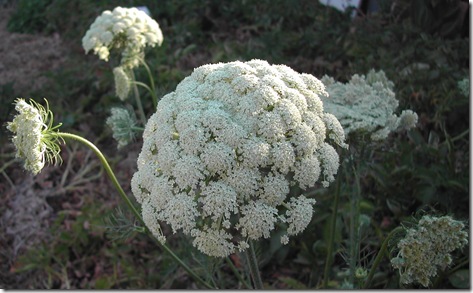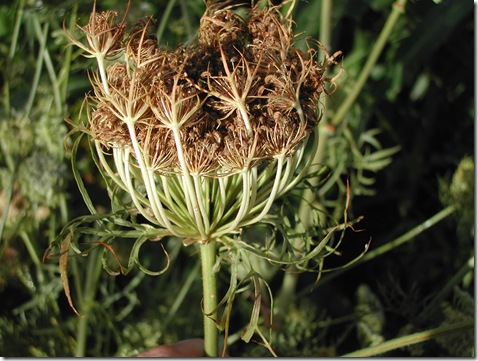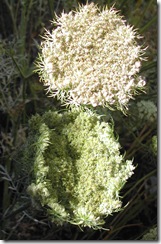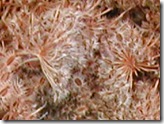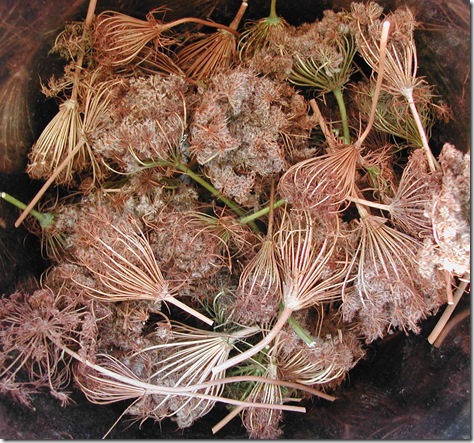If the backbone of winter vegetable production from the kitchen garden is broccoli, then that of the summer garden is a steady supply of lettuces for use in our daily salads. For this reason, I grow lettuces near the house; it’s then only a short walk for the cook to gather the ingredients together to whip up a salad. 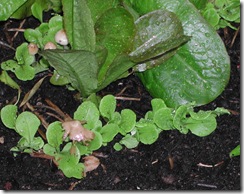 Other handy vegetables nearby are salad tomatoes, a favourite cucumber plant, chives, rocket, parsley, coriander and basil, celery, beetroot, dwarf beans and red salad onions. All these vegetables are cosseted in the richest soil I have, hand-watered from our big rainwater tanks (our lowest salinity water) and kept at maximum freshness and tenderness by the gardener at all times. Such is the simple road to happiness for a man who would rather toil for an extra hour in the sweltering sun than face the perils of the kitchen stove himself.
Other handy vegetables nearby are salad tomatoes, a favourite cucumber plant, chives, rocket, parsley, coriander and basil, celery, beetroot, dwarf beans and red salad onions. All these vegetables are cosseted in the richest soil I have, hand-watered from our big rainwater tanks (our lowest salinity water) and kept at maximum freshness and tenderness by the gardener at all times. Such is the simple road to happiness for a man who would rather toil for an extra hour in the sweltering sun than face the perils of the kitchen stove himself.
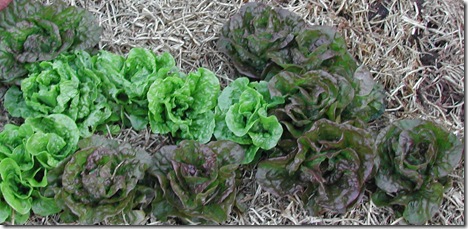
Further down the garden are the production beds, growing far larger crops that are used less often; climbing and dried beans, zucchinis, pumpkins, corn, potatoes, silver beet and sunflowers for the chickens, kale, serious numbers of tomatoes for bottling, eggplants, capsicums and so forth. Here’s where the chickens roam, keeping slugs, bugs, weeds and snails at bay while providing fresh rich eggs for our evening supper or Sunday breakfast.
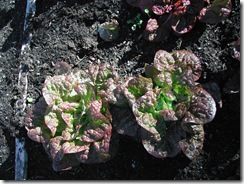 Lettuce, then, is consumed at an alarming rate, particularly when our growing family comes around for a meal.This is where seed-saving pays off; I produce so much lettuce seed that I can afford to broadcast it far and wide as Mother Nature would, and take my losses on germination or bird damage. I can also afford to give it away to fellow gardeners by the handful, bringing a light to their eyes at such bounty.
Lettuce, then, is consumed at an alarming rate, particularly when our growing family comes around for a meal.This is where seed-saving pays off; I produce so much lettuce seed that I can afford to broadcast it far and wide as Mother Nature would, and take my losses on germination or bird damage. I can also afford to give it away to fellow gardeners by the handful, bringing a light to their eyes at such bounty.
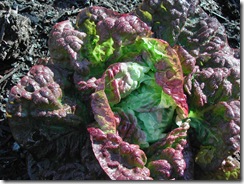 Growing lettuce is a cyclical business, and goes on here year round, as we can produce lettuce even during the frostiest of times in our mild Mediterranean climate upon the Adelaide Plains. New seeds are planted into trays of potting mix (or good friable soil) each time a tray of lettuce seedlings moves off to the garden. This happens every four to six weeks. I normally bury these trays to their lips in among the growing lettuces; that makes them feel at home, and keeps them cool and watered. The surface of the soil is simply scraped back to about one centimetre (half inch) depth, lettuce seed sprinkled over it like salt on a good steak, then the soil scraped back over the top and patted down and watered (with rainwater). This whole process takes about five minutes, including fetching and returning my tin of mixed lettuce seed from and to the shed.
Growing lettuce is a cyclical business, and goes on here year round, as we can produce lettuce even during the frostiest of times in our mild Mediterranean climate upon the Adelaide Plains. New seeds are planted into trays of potting mix (or good friable soil) each time a tray of lettuce seedlings moves off to the garden. This happens every four to six weeks. I normally bury these trays to their lips in among the growing lettuces; that makes them feel at home, and keeps them cool and watered. The surface of the soil is simply scraped back to about one centimetre (half inch) depth, lettuce seed sprinkled over it like salt on a good steak, then the soil scraped back over the top and patted down and watered (with rainwater). This whole process takes about five minutes, including fetching and returning my tin of mixed lettuce seed from and to the shed.
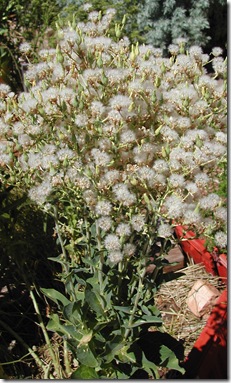 A single lettuce plant, left to run to seed, will produce hundreds of seeds, all viable for some years to come. Like cabbage and broccoli, all those leaves on a lettuce plant are in fact one above the other on a short stalk. All of a sudden, this stalk elongates and stands a metre or more high, with the leaves all along it and lots of flower heads all over the top. Once this flower stalk and head dry out (the yellow petals disappear, to be replaced by white fluff), simply cut the stalk off the plant, and bang it about inside a large garbage bin to release the seed. Wait a few days, as all sorts of tiny insects and flies need time to brush themselves off and walk off. Then simply tin the lettuce seeds. It’s that easy.
A single lettuce plant, left to run to seed, will produce hundreds of seeds, all viable for some years to come. Like cabbage and broccoli, all those leaves on a lettuce plant are in fact one above the other on a short stalk. All of a sudden, this stalk elongates and stands a metre or more high, with the leaves all along it and lots of flower heads all over the top. Once this flower stalk and head dry out (the yellow petals disappear, to be replaced by white fluff), simply cut the stalk off the plant, and bang it about inside a large garbage bin to release the seed. Wait a few days, as all sorts of tiny insects and flies need time to brush themselves off and walk off. Then simply tin the lettuce seeds. It’s that easy.
 We have to get all our vegetables planted out in March*. Any later than that and the seedlings sit in the cold soil, shiver, complain and do nothing. They just don't grow.
We have to get all our vegetables planted out in March*. Any later than that and the seedlings sit in the cold soil, shiver, complain and do nothing. They just don't grow. It's a risky business, though. We might still get a heat wave. And if that happens after I've planted out the tender little seedlings, well, they'll be cactus. So, I sow more than I need. Just in case.
It's a risky business, though. We might still get a heat wave. And if that happens after I've planted out the tender little seedlings, well, they'll be cactus. So, I sow more than I need. Just in case. *I am talking about our particular place in the Adelaide Hills. Autumn hits earlier here, than in the city. Every place is different. :)
*I am talking about our particular place in the Adelaide Hills. Autumn hits earlier here, than in the city. Every place is different. :)

